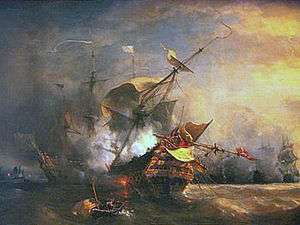Battle at The Lizard
| Battle at the Lizard | |||||||
|---|---|---|---|---|---|---|---|
| Part of the War of the Spanish Succession | |||||||
 Battle at The Lizard (1707), by Jean Antoine Théodore de Gudin. | |||||||
| |||||||
| Belligerents | |||||||
|
|
| ||||||
| Commanders and leaders | |||||||
|
|
| ||||||
| Strength | |||||||
|
5 warships 80–130 merchant ships | 13 warships | ||||||
| Casualties and losses | |||||||
|
1 warship destroyed, 3 captured Approx. 15 merchant ships captured 1,000+ dead | No ships lost | ||||||
The naval Battle of the Lizard (French: Combat du Cap Lézard) took place on 21 October 1707 during the War of the Spanish Succession near Lizard Point, Cornwall between two French squadrons under René Duguay-Trouin and Claude de Forbin and an English convoy protected by a squadron under Commodore Richard Edwards.[1]
Duguay-Trouin and Forbin were two of the most successful French naval commanders and they caused much damage to the allied merchant fleet.
Battle
On 20 October 1707 a large merchant fleet consisting of 80 to 130 English ships left Plymouth for Portugal with supplies for the war in Spain. There were five escorting English ships under command of Commodore Edwards.
The next day near Lizard Point they were spotted by 2 French squadrons of 6 ships each. Technically Forbin was the senior French officer, but Duguay-Trouin was the more aggressive, and his ships led the attack and suffered most of the damage, after Forbin had discovered the British convoy.
This battle was almost a complete victory for the French; the 80-gun Cumberland and the 50-gun ships Chester and Ruby were taken, but Royal Oak escaped into Kinsale with a few merchantmen. The 80-gun Devonshire defended herself for several hours against seven French ships until she caught fire and blew up, only three men escaping out of 500.[2]
Ships involved:
Britain (Richard Edwards)
- Cumberland 80 - Captured by Lys and Gloire
- Devonshire 80 - Exploded
- Royal Oak 76 - Escaped
- Chester 50, Captain John Balchen - Captured
- Ruby 50 - Captured
80 to 130 merchant ships
Notes
- ↑ Allen p. 103
- ↑ "Devonshire". Pastscape. English Heritage. Archived from the original on 12 March 2016. Retrieved 6 January 2013.
There is no unanimity on the number of merchant ships captured. French sources speak of 60 ships out of 80, some British of none at all. The fact that René Duguay-Trouin and Claude de Forbin quarrelled for many years about which of the two squadrons had the biggest role in the victory, points to a considerable number of ships captured. Probably the truth is somewhere in between: Polak in "Bibliographie maritime française" speaks of 15 merchant ships captured.
References
- Allen, Joseph. Battles of the British Navy: from A.D. 1000 to 1840. Bell & Daldy publishing (1872) ASIN: B00087UD9S
External links
- Jean et Michèle Polak: "Bibliographie maritime française"
- Commission Française d'Histoire Militaire (English)
- HMS Chester
- HMS Devonshire